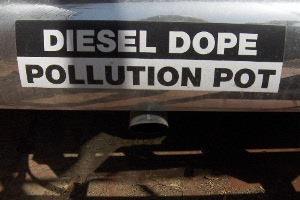What’s happened is layered. Hardy says the federal government, in conjunction with local and state law enforcement, started coming down heavy on outdoor marijuana growers. Many moved indoors, using diesel generators to power lights and fans. They found they could harvest multiple crops a year, and make a big profit. These rural areas, which used to be totally quiet at night, now had a new soundtrack: the low hum of generators. Diesel generators require lots of fuel (which often leaks) and anti-freeze (which often spills). Trickle leaks get into the water table; dramatic leaks have put as much as 1,000 gallons of diesel at a time into local creeks.
To Hardy and others, this real and potential environmental damage was unacceptable, and just not neighborly.
“It’s been a wonderful place to live until the indoor growing got out of hand. My first inclination is to live and let live, but there’s an old saying that your freedom ends half-way between your and my nose. And what has happened with the diesel dope, the diesel spills, the air pollutions, and just the disregard for the land, has been tempering my hospitality.”
A small movement grew to call out “diesel dope” growers, and tell them to clean up their act. Folks were hesitant to join in, at first. Then, in 2008, a meeting of about 50 outdoor growing advocates met. Out of that gathering came Put ‘Em In The Sun, a group trying to spread the word about growing pot naturally. “Most people in the campaign weren’t in-your-face campaigners, and so they wanted to appeal to the positive in people,” says Hardy. Put ‘Em In the Sun showed up at arts festivals, started underwriting shows on community radio stations, and put ads in county newspapers. These ads read more like instruction manuals: how and when to legally collect water (instead of diverting from creeks and streams), best methods for germinating seeds (and organically keeping critters away), and where, exactly, to plant.
Hardy thinks these actions are steps in the right direction. “I think that we are losing touch with Mother Nature. I would like to see people in all walks of life have more regard to what we are doing to the environment. One of the most obvious [ways] up here is growing your marijuana outdoors, growing it organically. And it doesn’t hurt your neighbors.”
40.207196906764054 -123.74588012695312

